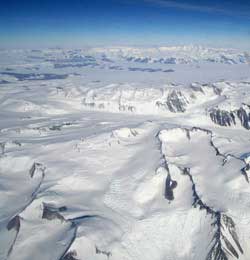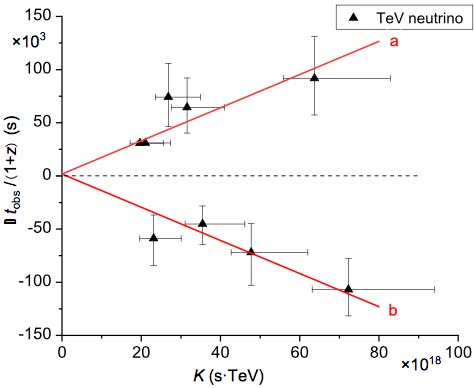|
Neutrinos are cousins of electrons, but have no electric charge and are about a million times less massive. We believe the highest energy neutrinos are produced by cataclysmic explosions in remote galaxies. Neutrinos interact extremely weakly with other particles, so they arrive here almost completely unaffected by everything they pass through.

For seven years, the IceCube Neutrino Observatory at the South Pole has analyzed high-energy neutrino interactions deep within the ice sheet covering Antarctica.
Based on IceCube data, Chinese physicists Yanqi Huang and Bo-Qiang Ma of Peking University have just published strong evidence of a major scientific discovery: faster-than-light neutrinos that may reveal the quantization of space and time.
Faster than light? In the past, several physicists have claimed to have discovered faster-than-light particles — my September 2011 newsletter discussed one example. Every prior claim was ultimately proven false, due to faulty equipment or erroneous logic. This time may be different.
Quantized spacetime? If space and time are quantized, rather than continuous, each would have a smallest increment — no distance could be less than 1 quantum of space, and no time interval shorter than 1 quantum of time. Also, the quantum of time would be how long light takes to travel 1 quantum of space.
In classical physics, and everyday life, time is considered continuous, as illustrated by an analog clock (remember those?). Any time of day, such as 12 hours, 34 minutes, and 56.789 seconds is represented by some combination of the positions of a clock’s hands. Even if we can add 50 or more digits after “789”, there will always be an instant when the continuously-sweeping second hand indicates that time.
Conversely, a digital clock displays quantized time. It might say 12:34:56 and later abruptly change to 12:34:57. For this clock, there are no instants of time between those values. This clock’s quantum of time is 1 second.
Why do we care?
Quantum mechanics and relativity — the two great pillars of 20th Century physics — both make absurd predictions as we probe distances and time intervals that approach zero. Many physicists, myself included, believe the failures of our cherished theories stem from our failure to understand space and time at the smallest scales. All our physical theories employ calculus, which assumes continuous variables, including space and time. If space and time are in fact quantized, we will have to revamp the mathematical basis of our theories, which might eliminate their current absurdities.
Huang and Ma searched IceCube’s database, looking for extremely high-energy neutrinos, which are quite rare. They found 9 instances in which an extremely high-energy neutrino arrived at about the same time and came from about the same direction as a gamma-ray burst (GRB) observed by other instruments. The energy of these neutrinos ranged from 63 to 385 TeV, equal to 5,600 to 34,000 times the mass-energy of a single carbon atom. Our most powerful particle accelerator, the LHC, has a maximum energy of 6.5 TeV in each of two beams.
GRBs are known to originate in some of nature’s most violent explosions, mostly supernovae and the collisions of neutron stars. These explosions emit gamma rays almost immediately, and later emit less energetic radiation — x-rays, ultra-violet, visible light, infrared, and radio waves. Analysis of light at various wavelengths yields the redshift of the source, and thereby its distance from Earth.
Assuming each GRB / neutrino pair came from the same explosion at the same time, and assuming gamma rays travel at c, the speed of light, the authors calculated the speed of each neutrino. Special relativity says a neutrino’s speed gets closer and closer to c as its energy increases, and at 63 TeV, a neutrino’s speed v = 0.99...995 c, where “…” represents 25 more 9’s. This v – c difference is far too small for us to detect, so special relativity says any actual measurement will show v = c.
But instead, the authors discovered this:

Here, the horizontal axis is proportional to each neutrino’s energy, while the vertical axis is proportional to v – c, its speed minus the speed of light. Each neutrino event is marked by a black triangle, with bars indicating the measurement uncertainties. (The two leftmost events are nearly on top of one another.)
These extremely high-energy neutrinos arrived from 64 hours earlier to 41 hours later than their associated GRB. Since their total travel times averaged 7 billion years, these arrival time differences are only parts per trillion.
Five of the neutrinos traveled very slightly faster than c, while the other four traveled very slightly slower than c. There is a clear trend of linearly increasing deviation with increasing neutrino energy (the two red lines).
While we have no cogent theory of how particle velocities might change in quantized space, the effect is clearly very small at even the highest energy we can probe. The authors therefore make the simplest assumption: the change is linearly proportional to energy (the leading term in a Taylor series expansion). Their linear fit for these 9 neutrinos yields:
(v – c) / c = s × E / E*
E* = (641 ± 53) trillion TeV
Here, v is the neutrino velocity, E is its energy, and s=+1 for slightly faster neutrinos and s=–1 for slightly slower ones. The fit quality is 98.7% (100% is a perfect fit). E* is the amount of energy that provides the best straight line fit to the data. The energy of very fast particles is inversely proportional to their wavelength. The fitted value E* corresponds to about 1/3rd of a millionth of a trillionth of the diameter of a single proton. This is about 20 times the Planck length, our best prior guess at the size of one quantum of space.
Why are some neutrinos faster and some slower than light?
Without a cogent theory of velocities in quantized space, the authors suggest that, as energy increases, the neutrino velocity change and the antineutrino velocity change might be equal in magnitude but opposite in polarity — one would go faster and the other would go slower.
That suggestion violates a fundamental principle of quantum mechanics: the CPT theorem. But the CPT theorem assumes Lorentz invariance, which in turn assumes no thing moves through space faster than light. If quantized space permits faster-than-light motion, all these principles need revamping.
At very high energy, IceCube cannot distinguish neutrinos from antineutrinos, so the data cannot fully confirm the authors’ suggestion — no one knows if the particle or the antiparticle is faster.
The authors also identified 4 ultra-high-energy neutrino interactions, with the highest energy being 2,600 TeV. However, these events have larger measurement uncertainities, are more difficult to associate with GRBs, and the most likely GRBs lack measured redshifts. The authors showed that, after filling in the missing data with reasonable guesses, 2 of the ultra-high-energy neutrinos are consistent with the upper line in the above graph, while the other 2 are consistent with the lower line. This is comforting, but does not improve the quantitative analysis, so these 4 events are not included in the quoted result.
Is all this real?
Physicists generally demand compelling proof for dramatic breakthroughs. There will certainly be a lot of discussion and much careful, perhaps even hostile, scrutiny. We will want confirmation from independent researchers. The drama may continue for a few years before reaching a general consensus.
This is all very exciting! I am hopeful that this could be the breakthrough we have awaited for decades.
Best Regards,
Robert

July 24, 2018
Note: Previous newsletters can be found on my website
|